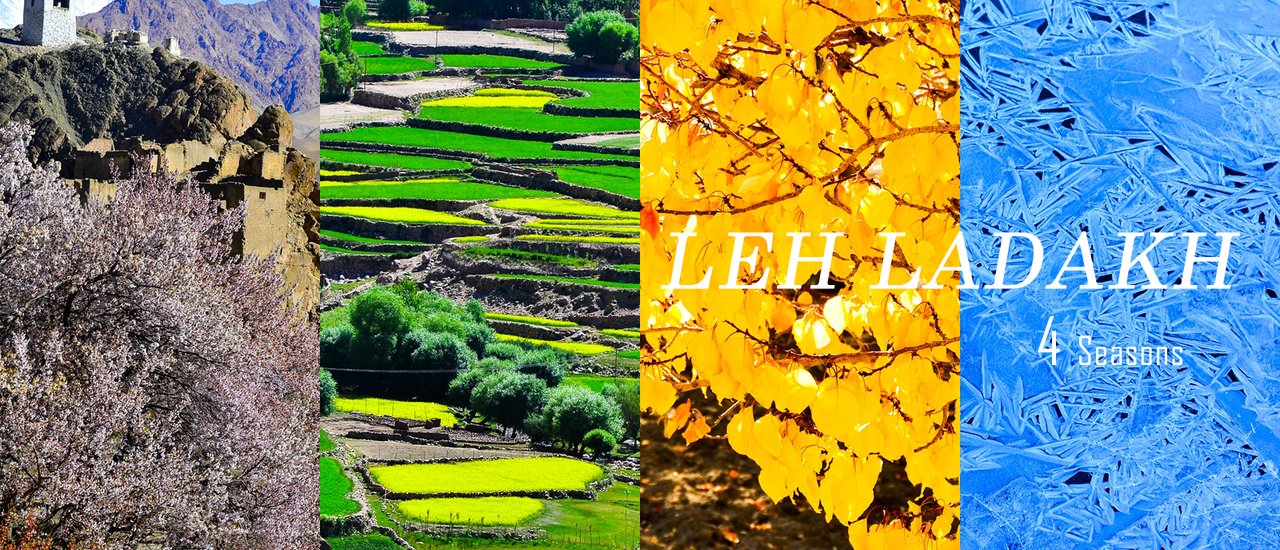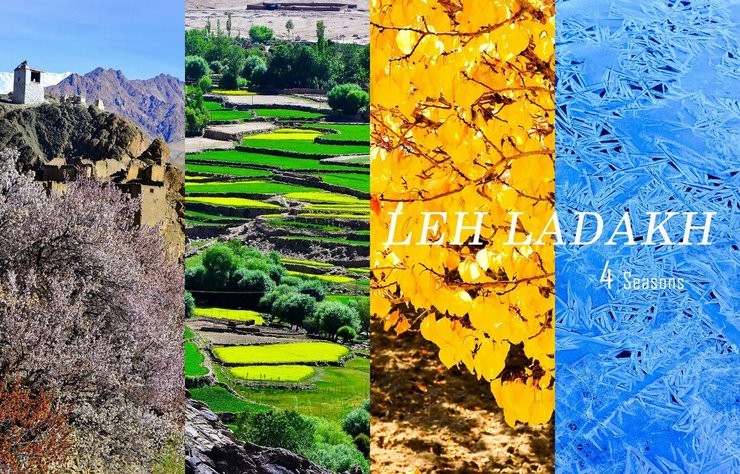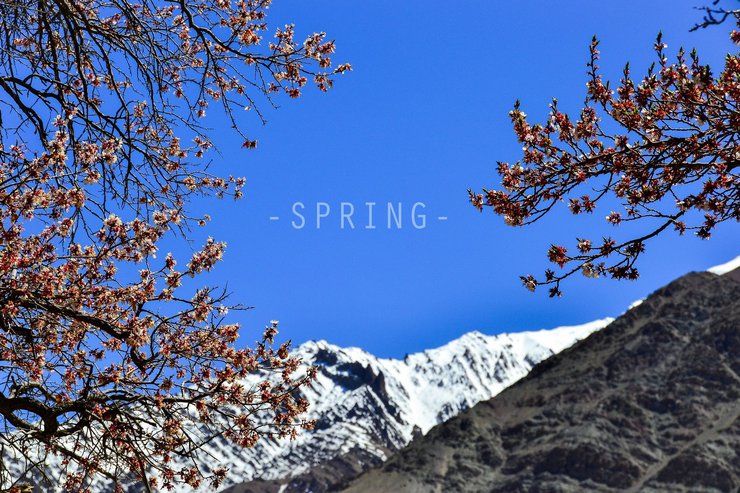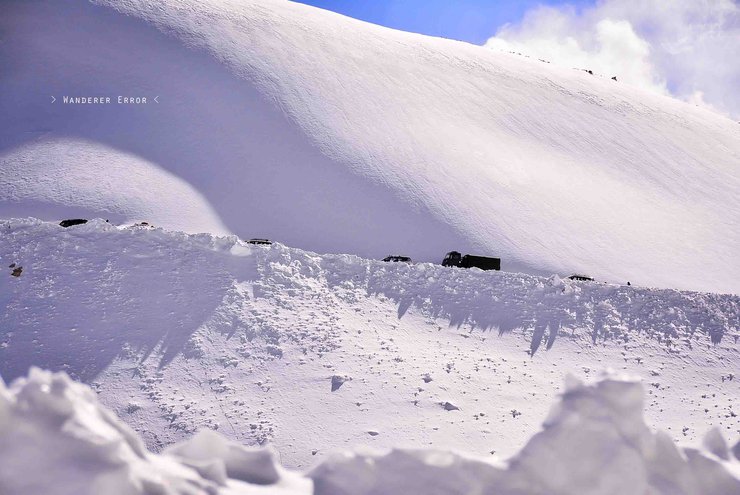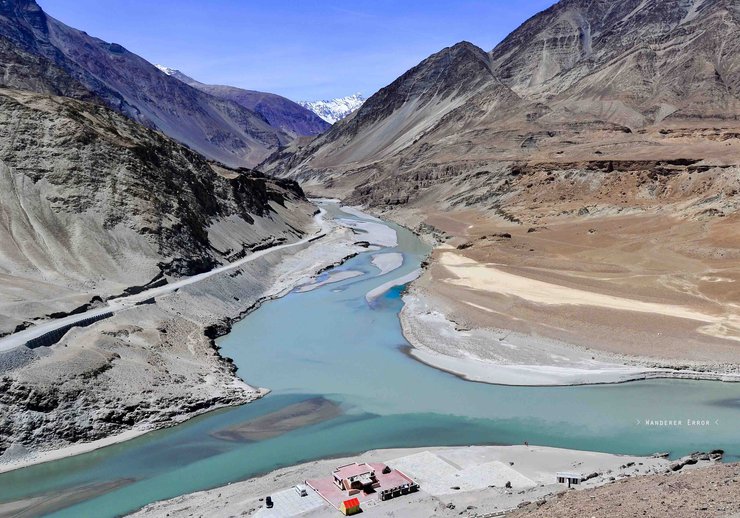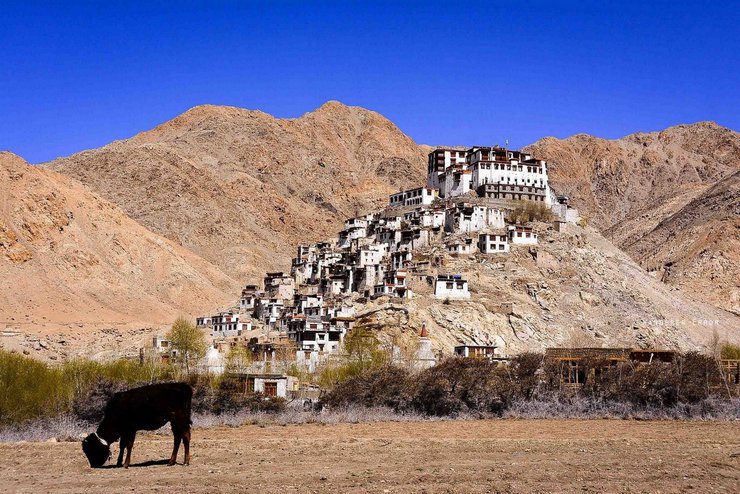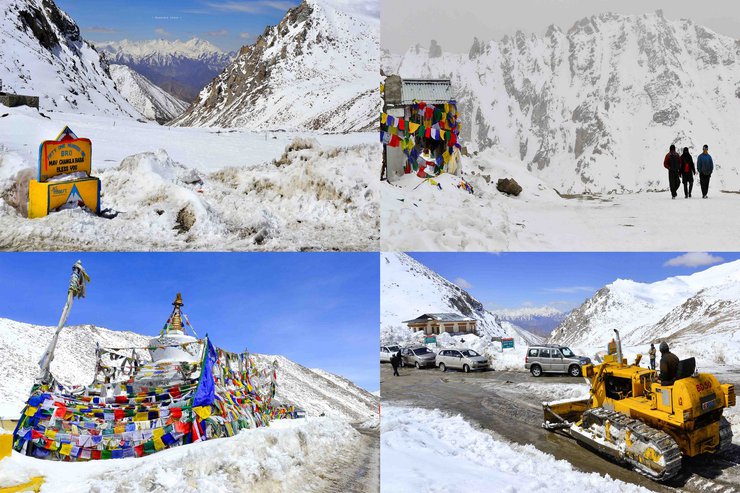
The Allure of Leh Ladakh: A Himalayan Paradise
Leh Ladakh, nestled amidst the majestic Himalayas, has become a renowned destination for adventure-seeking travelers. Word-of-mouth recommendations have propelled its popularity, attracting those who yearn to explore the region's captivating landscapes.
However, the unpredictable weather conditions of this small Tibetan territory may leave young and old backpackers wondering when the best time to visit is and what makes each season unique.
This post will showcase the beauty and unique characteristics of each of the four seasons in Leh, along with the surrounding tourist attractions, to help you decide which season you'd prefer to visit.

Spring
Late March - May
| The Beginning |

The biting cold of winter transforms the city into a ghost town, but as spring arrives, life reawakens. Lush greenery emerges, and cherry blossoms paint the gardens surrounding Leh with vibrant hues of pink and white. These blossoms eventually give way to apricots and apples, while the tranquility of Leh remains undisturbed by the absence of large tourist crowds.

- Confluence of the Indus and Zanskar Rivers -
Hotels and shops owned by foreigners are gradually reopening and cleaning their premises in anticipation of welcoming tourists once again.

- Spring above | Summer below -

During this period, the pass will be covered in a significant amount of snow, providing ample opportunities for snow activities. However, it is important to note that road travel to Leh from Srinagar or Manali via the highway pass is subject to weather conditions. If the snow on the pass between the regions has not melted by the scheduled opening date, the opening may be delayed. Therefore, travelers planning to visit during this time should be prepared to take a flight instead if the pass remains closed.

The weather is still unpredictable. Sometimes the weather is bad, with heavy snowfall, and the passes in Leh are suddenly closed. This is a matter of luck, and passes can be closed in any season.

- Snow on Chang La and Khardung La -



The availability of food depends on whether the pass is open or not. This is because some items need to be imported from other cities. We have experienced situations where there were no eggs, vegetables, or even a single bottle of Coke. The only available items were old stock that had been left over from before the Sojila-Rotangla Pass was closed.

During this period, Leh offers a tranquil atmosphere with stunning views of snow-capped mountains juxtaposed against blooming cherry blossoms. This season is ideal for those who prefer cooler temperatures and moderate snowfall, without the harshness of extreme cold. The serene and uncrowded environment further enhances the charm of this season.


Popular tourist destinations such as Nubra Valley and Pangong Tso Lake remain accessible and offer stunning views, especially on clear days. While some parts of the lake may still be frozen, this adds to the scenic beauty.

The Sochi and Rohtang La passes are typically open from late April to October.
Temperature: -5 - 12

Summer
June - August
| Joyful and Lively |

This is an empty paragraph with a center alignment.
As the weather gradually warms, the slopes of the valley are adorned with vibrant green poplar leaves. Fields of mustard flowers bloom in full splendor, interspersed with barley fields, creating a picturesque landscape of alternating yellow and green hues. The lush vegetation and vibrant colors evoke a sense of vitality and abundance.


Along the way, wild flowers in yellow, purple, and pink colors bloom sporadically among the crevices of rocks and mountains. Yaks and donkeys graze peacefully, enjoying themselves. Marmots awaken from their hibernation under the ground during the winter season, which is a common sight during this time. They frolic and play, as if welcoming tourists.

The end of July to August marks the peak of the hot season. During the day, the sun is strong and the heat is intense. At night, the weather is pleasant and the sky is clear, making it ideal for stargazing and astrophotography. The weather is not too cold, making it comfortable to enjoy a beer while watching the stars. However, the mustard fields may no longer be in bloom, and the rice fields will start to turn yellow as they ripen.

- Mid-July -

- Mid-August -

The glacial meltwater has turned the river a muddy brown, carrying sediment downstream. If you're hoping to see snow, you might still find some in Kardung La.

- Traffic jams on the pass | Enough snow to play with -

This season offers a wider range of activities than any other, including camping, cycling, motorcycling, trekking, and rafting. Both routes (Srinagar-Leh or Manali-Leh, each with its own unique beauty) are accessible by car, and the Zanskar Valley is also a great place to visit during this time.

Parkachik Glacier

- Suru River -

- Likir Gompa -

Ney Gompa

- Rohtang Pass | Manali - Leh highway -

- Moriri Lake | Korzok -

This period coincides with the peak tourist season, attracting visitors from all over the world, including India. The pleasant weather and the Hemis Festival, a major masked dance festival held at the Hemis Monastery, one of the largest and most important monasteries in Ladakh, contribute to the influx of tourists. During the festival, locals adorn themselves in traditional attire and participate in processions. (The festival is typically held in June-July, coinciding with the birthday of Guru Padmasambhava, on the 10th day of the 5th month of the Tibetan calendar. In 2016, a grand celebration will be held every 12 years, during which the largest Thangka painting in Ladakh will be unfurled for public veneration. We have not yet had the opportunity to attend the festival during this special occasion.)

While Leh offers the warmest weather during this season, it also experiences the highest tourist influx and dust levels. If you plan to visit during this peak season, especially with a large group, it's advisable to book transportation and accommodation well in advance. The scenery is stunning, with pleasant nights and intensely hot days under clear skies. However, finding peace and solitude might be challenging due to the crowds. Be prepared for a lively atmosphere and adjust your expectations accordingly.


- Pangong Lake -

Food is plentiful, and any menu item can be prepared. All restaurants and shops are open, with popular establishments naturally experiencing high volumes of customers. Among the most popular are Chopsticks, Gesmo, and Summer Harvest (these are my personal favorites in Leh). Clothing, jewelry, scarves, handmade items, and tour counters are all bustling with activity.
Temperature: June = 3 - 16, July = 7 - 21, August = 10 - 25

Autumn
Oct - Nov
| All good things must come to an end |

After August-September, the rainy season begins, bringing erratic weather, but it is a short period.


The leaves begin to change color before they fall, but the timing must be just right. The intensity of the color change depends on the weather conditions each year. (Sometimes, just as the leaves are about to reach their peak color, a heavy rain or windstorm can cause them to fall prematurely.)

It is said that the leaves are most beautiful in mid-to-late October in previous years. However, in 2015, the cold weather arrived late, so the most beautiful time was in early November. (Fortunately, I couldn't go in October, so I came during this period instead, which was the perfect time for the yellow leaves.)


Leh during this period is undeniably captivating, exuding a serene and romantically melancholic aura reminiscent of autumn elsewhere. However, Leh's solitude is authentic and profound, setting it apart from other destinations.

As the low season approaches, many hotels and shops begin to close down due to the cold weather, which makes it unprofitable to remain open for the dwindling number of tourists. Amenities become increasingly scarce, similar to the winter season when temperatures drop below freezing at night.

The road from Srinagar or Manali to Leh is closed around October. If it is closed, the only way to travel to Leh is by plane.


Despite the lack of dense forests that typically turn golden in autumn, the surrounding landscape offers a captivating romantic ambiance. The contrasting heights of the towering poplar trees, the crystal-clear streams, and the arid sandstone mountains create a visually striking scene, enhancing the allure of this region.

Photography enthusiasts will be captivated by the interplay of light and shadow cast by colorful leaves against the sky, making it an enchanting experience that eliminates the need for distant travel.

- The birthday person wears an orange outfit. -

- A grand birthday celebration, traditionally held only once in a lifetime.
During this period, until the start of winter, we may have the opportunity to witness and participate in local traditional events. This is because it is a popular time for the Laodak people to hold events, such as weddings (a friend told me that winter is a time for leisure and relaxation, so they tend to hold events during this time). As for me, I happened to come across a birthday party and was able to join in the festivities.

- The Aryan-descended people of Ladakh -

The current travel season is experiencing some difficulties with restaurants and hotels, but the weather is not as harsh as during the winter months. There are still some tourists walking around.
Temperature: 0 - 5

Winter
November - March
| A return to what Leh truly is: pure serenity. |

The city becomes almost deserted during this season. Over 80% of hotels, shops, and restaurants are closed, leaving only a handful open. While these options may seem limited, the kindness of the locals who go out of their way to help us makes up for it.

The landscape around Leh is blanketed in snow and ice. Streams flow with a serene, turquoise hue, their waters settling into tranquility. Life unfolds in its simple beauty, each creature fulfilling its role in the grand tapestry of existence. The majestic Himalayas witness the return of their native fauna, reclaiming their domain with newfound freedom, unburdened by human intrusion.


- A young child ice skates on a stream in front of their house. -
- Cycling up this pass is not for the faint of heart. If something happens, it will be difficult to find help. -
- Fox -
- I'm not sure what happened to this unfortunate creature. I saw it limping by the side of the road. -

The harsh conditions were exacerbated by the frigid temperatures, with daytime lows of -10 degrees Celsius and nighttime lows of -20 degrees Celsius. Streams froze solid, bottled water left outside turned to ice, and indoor plumbing ceased to function, requiring water to be carried in buckets. Bathing became a rare luxury.

We survived the trip by huddling together for warmth at night, or by asking to sleep in the common room of guesthouses with fireplaces, even if we had already paid for accommodation. As for heaters, some hotels have them, but they may charge extra.

- Every morning, I encounter this. -

I remember a funny incident. We didn't know that the small plug-in heater in the bathroom was meant to be left on all the time. We were happy to find a heater and moved it to our room. The next day, the owner saw it and told us that it was for the bathroom, not for guests. I thought to myself, "Why would you heat the bathroom? We're freezing in our room!" My friend Leigh explained that if the bathroom wasn't kept warm, the water would freeze in the pipes and cause them to burst, leading to expensive repairs. So, the heater was necessary for the bathroom. I finally understood. Haha.

- Ice fell into the eye -

In Leh, there are two types of heaters. High-end hotels (4-5 stars) typically use large, white panel heaters (which sometimes malfunction). The other type is a gas tank heater, which must be turned off before sleeping due to safety concerns. As a result, we rarely used it. Instead, if we weren't sleeping together, we would take our sleeping bags to the living room with the fireplace. This kept us warm.

- The Empty Quarter with Idled Camels -
Year-round hotels range from 5-star to guesthouses, but only a few are open. It is advisable to book in advance. Although it is the low season, winter prices are higher than summer prices because services are more difficult to perform due to the weather. Each hot water tank that is boiled for us requires manual lifting of the tank, which is tiring to watch. As for transportation, if you do not book in advance, you can still find taxis at the Taxi Stand near the Main Bazaar in the city center.

- Pang Ung Lake, frozen due to the cold.

While most restaurants remain closed, eggs and chicken are readily available during this season due to existing stock from before the Passover closure. Visitors during this period need not worry about food shortages. Fresh fruits are also available.

Winter activities include ice hockey competitions and the Chadar trek (Zanskar river trek), a challenging trek on the frozen Zanskar River leading to remote villages in the Zanskar Valley. The trek typically takes 9-10 days to complete roundtrip.
If you visit Ladakh in December, you will encounter the Ladakhi Losar New Year celebrations. In 2015, the festival was held on December 12th, according to the Tibetan calendar.

Traveling during this season carries a higher risk of encountering road closures at Kardung La and Chang La compared to other seasons. However, surprisingly, when we visited in February, we managed to pass through both passes without any issues. Notably, the passes had been closed for several days before our arrival. Additionally, we were fortunate enough to attend a sermon delivered by His Holiness the Drukpa, the head of the Red Hat sect, at Hemis Monastery.
- The Khardung La pass, leading to Nubra Valley, and the Chang La pass, leading to Pangong Lake, are open year-round except in cases of heavy snowfall or landslides. Their accessibility depends on weather conditions.

Temperature: -20 - 2
Our younger sibling made a short video clip, probably because they didn't record much. Haha. https://www.youtube.com/watch?v=Uh1zYWAsDaQ

The weather in Leh is unpredictable, regardless of the season. Some people visit during the summer but encounter road closures, landslides, or cloudy skies. During the transition seasons, there is a risk of encountering overcast skies. Predicting the weather is difficult, as conditions can change rapidly. For example, the sky may be clear one day and overcast the next. Therefore, we cannot guarantee that you will experience specific weather conditions during your trip. We have written this based on our observations and analysis, hoping it will be helpful to others.
However, if you ask which season is the most convenient for tourists and offers the best chance to visit all the attractions, including the surrounding villages, it would be the summer season. However, it is also the peak tourist season, so expect larger crowds. Weigh the pros and cons carefully before making your decision.

The environment and landscape of each season are different, as shown in the pictures. (We apologize if some pictures do not look very different, we tried our best.)
Friends may wonder who I am and why I visit so often. I am a tour guide, sometimes working on trips and sometimes traveling on my own.
Personally, I love autumn and winter the most. Even though I have to endure the cold, it is very peaceful. Just taking photos, enjoying the view, and chatting with the locals, without anyone bothering me, and with few tourists around, makes me feel peaceful and happy. Moreover, the scenery is incredibly beautiful and pure.
Thank you for reading.
Love to everyone who loves Leh.
Oil / Wanderer Error
Wanderer Error
Friday, September 27, 2024 10:27 AM

